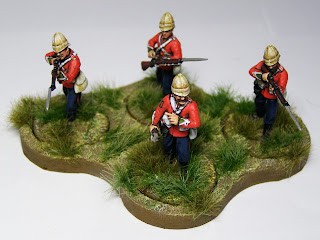So, it happened again! The change to a new historical period, messing up plans of completing other armies, and yet an exciting and interesting change that enlivens the hobby and keeps it ever interesting.
I blame the new period on getting to fire my Martini-Henry rifle at the range for the first time last month. I have owned it for about 3 years but never got around to getting the ammo or the kit to make the rounds up. When I finally had made some ammo, off to the range I went...and I don't think the smile left my face for a week!
So enthused in spirit I purchased a copy of the Warlord Games 'Zulu!' book for their Black Powder rules. I have to say how impressive these are too. Each scenario seems to have a completely different approach to the game, from using small sections for Rorke's Drift to companies for Isandlwana and to battalion units for the final large battles. I really like the thinking behind it and it got my imagination racing even more.
I placed an order for Perry's Anglo-Zulu War British Infantry and I have to admit to stopping another project on my work bench to throw myself into making and painting these. I even took the figures with me to construct and start to paint when I had to spend a week working away from home.
I have started with a 16 man unit instead of my usual 24 - the idea being that I can now downscale the number of Zulu's I need by 1/3rd on this ratio. There are already going to be plenty of Zulu's but I do want some room on the board for figures to move!
As usual with plastic figures from the Perry's, the troops were a joy to construct with not too many parts and nothing especially weak. A couple of bayonets did get clobbered by my clumsiness during construction, but nothing broke or bent. There are 38 figures in the box including casualties which gives a great mix. I'll make and paint the standard bearers at a later date. They are in the box too along with the Colours for four regiments on the printed sheet supplied.
The commander of this unit (for it will be a company or battalion depending on scenario) is not of the Stanley Baker/Michael Caine clean shaven appearance but has the full 'eating a bear' beard popular of the time.
As a small digression I should mention that these are the first 'proper' colonial period figures that I have...which amazes me! The history of this period is just so incredibly interesting and the redoubtable British Soldier was active all over the place with his trusty Martini-Henry. I do have Esci 1/72 Zulu War plastic figures in the attic but it has been a long long time since they were painted and saw daylight.
I used the Foundry Triad colours particularly useful using British Napoleonic colours mostly and the French Dragoon greens for the cuffs and collars.
I really wasn't sure how to base the troops and gave this a lot of thought. The casualties were always going to be based on Warbases casualty stands which give space for a small dice to be placed to show 'excess' casualties, as well as a numeric dial.
To give the greatest flexibility I decided to use circular single figure stands, again from Warbases, but in addition I purchased 4 man skirmish type movement bases and 5 man close order bases.
I chose the bases which could be fitted with their 'rare earth' magnets. These little magnets are great fun on their own! Prising them off each other was a great challenge and trying to drive two opposing tiny little magnets together was a real test on something so small! Amusingly when setting these photos up I discovered that one magnet was the wrong way up. The figure was ejected from the movement tray to my bafflement until I realised what I had done!
I had never used the magnets before and wondered if they were sufficient to hold the figures safely in their movement bases. I can safely say that the figures are well held. As a test I held the base upside down and shook it and there was no movement whatsoever from the figures.
It took me 6 weeks to get these chaps painted up. This involves research and doing lots of other things at weekends and I am now ready to paint something else! In my early enthusiasm I ordered a huge battle set of Rorke's Drift from 4Ground with many boxes of Warlord Games Zulus. I decided that I would keep this box as my gift to myself at Christmas so I have yet to open it! I am sure I will be ready to paint more British Infantry then...and Zulus........... 'Tharsands of 'em!'




















































